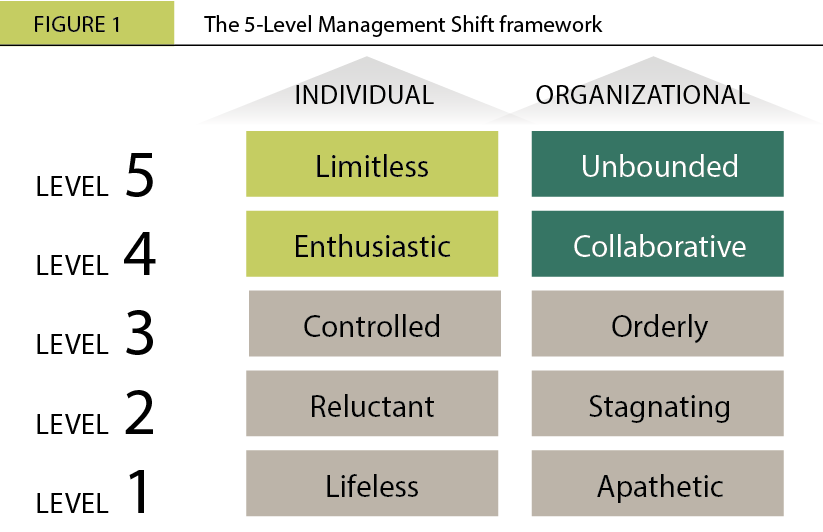The global pandemic has changed all aspects of our lives including the way that we are now working. As organisations are preparing to reopen, many leaders are wondering what kind of organisational culture they need to have right now to allow hybrid working places to emerge that are high performing and engaging. The success of these new hybrid workplaces will be significantly influenced by leaders’ behaviour.
Behaviours needed from leaders and organisational cultures that should be created now for hybrid workplaces can be examined through the 5 Levels of The Management Shift framework (Figure 1):

This 5-Level Model shows that there are 5 Levels that our individual mindset goes through, and there is a corresponding organisational culture at each level. Every level is characterised by specific thinking patterns, emotions, language used, leadership behaviour and organisational outcomes. We cannot skip the levels, but we often see pockets of different level within the same organisation.
At Level 1, people are depressed, fearful, worried and lifeless. Culture is often toxic with autocratic leaders. Not much gets done at this level. At Level 2, employees have a reluctant mindset, doing minimum they can get away with, just to get their pay cheque. They bring their body to work, but their heart and mind stay at home. Culture is stagnating and disengaging.
At Level 3, leaders lead by a command-and-control style, people are micromanaged, and the working environment is dominated by leaders with big egos who sometimes bully their staff. A complete management shift or the ‘Big Shift’ – to Level 4 – is required to enable organisations to survive and thrive, especially in the new hybrid workplaces.
At Level 4, culture is collaborative, mindset enthusiastic and there is a common purpose, trust, transparency, teamwork and collaboration. People have fun working and focus on common good. Such companies attract talent and the bottom line goes up steadily, because people are the focus rather than numbers. At this Level, there is a step change increase in performance, engagement, innovation and bottom line profit.
Occasionally, we can reach Level 5 with limitless mindset, working on some amazing innovations, solving big problems for humanity. However, it is impossible to maintain this level all the time without burning out, so the objective is to reach this Level occasionally, spend some time there and go back to Level 4.
It is apparent that levels 1, 2 and 3 relate to the old ways of working, the old ways of doing business with hierarchical organisations, command and control, standardisation, specialisation, fixed working hours, where people must spend certain hours at work and do what they are told to do by their boss.
Since March 2020, for many leaders it has become impossible to control and micromanage their employees due to remote working. Many employees have been enjoying the freedom to decide when, where and how they are going to do their work, and many surveys show majority of employees want to keep that freedom in the future. Leaders now need to embrace flexibility of allowing employees to continue working from home, whilst motivating them to spend some time in the office too so that social connections important for innovation can be maintained.
Whilst remote working has increased productivity, and employees appreciate flexibility, in many cases it has also masked imminent burnout, isolation from the lack of face-to-face interactions and absence of spontaneous conversations that can lead to a new big idea and new big innovation. Whilst remote working has its pitfalls, still the majority of employees prefer to have the flexibility of remote working. And those employers that intend to force their employees, who can work productively from home, to come back to the offices will lose their talent. And while many leaders say that people are the most important asset for their organisation, those that are requiring everybody to go to the office full time regardless of circumstances are not walking the talk.
So, what do leaders need to do now?
They need to embrace the hybrid working place where they can leverage the best of both worlds. They can allow people to work remotely as and when needed, convenient, and appropriate. So, people can do their work, either between nine and five o’clock, or during the evenings or weekends and balance their work with family responsibilities and social life. It is important that they find the balance between delivering the results that are needed for the company, while maintaining boundaries so that they don’t get overworked or too stressed out. On the other hand, it is imperative to encourage people to go to offices when possible to interact face to face and rebuild those human connections which have been lost since March 2020.
Here are the key steps leaders can take now to create high performing workplaces:
- Allow flexible working within boundaries, so that employees can choose when, where and how to do their work. Setup processes to ensure that they are encouraged to resume face to face interactions with their colleagues and clients. Show compassion for individual circumstances.

- Create opportunities for face-to-face networking, individual interactions, spontaneous conversations and social gatherings, as much as possible. Encourage those ‘water cooler’ moments because this is where the most important ideas get generated. Make workplaces look attractive, relaxing, flexible and inviting. Organise events for employees, use gamification to create a fun and safe working environment to share ideas and feedback.
- Empower employees to make the right decisions based on their knowledge, skills and experience, not on the basis of their position in the organisational hierarchy. This distribution of decision making will fuel performance, achievement of objectives and generation of new ideas.
- Be mindful of your purpose, help employees to discover their own purpose and align it with organisational higher purpose and provide a clear way forward. When this is achieved, employees will, in time, start working at Levels 4 and 5 of The Management Shift framework. They will go an extra mile for customers, they will be more engaged and more passionate about their work. Work purpose could form a foundation for the new hybrid workplace.
- Work on creating psychological safety by encouraging open, transparent, and two-way communication between leadership team and employees. Make sure that people’s voices are being heard and take action when appropriate, based on their views, suggestions and feedback. This will help build trust.
The above five points, when implemented with intention and care, will lead to creating successful, high performing and engaging hybrid workplaces that will speed up recovery both for individuals and their organisations. Cultures in those organisations will be caring, collaborative, people focused, purposeful, healthier, and happier. The time to create such workplaces is now.
This article is originally published on September 28, 2021.
About the Author

Vlatka Ariaana Hlupic is a Professor of Leadership and Management at Hult Ashridge Executive Education, Hult International Business School. She is the founder and CEO of the training, coaching and consultancy firm Management Shift Solutions Limited1 as well as the author of The Management Shift and Humane Capital books.




































